The world is not a problem to be solved; it is a living being to which we belong.
-- Llewellyn Vaughan-Lee
I am fascinated with little peoples, the nations around us who we simply don’t see, avoid or are dismissed as too ordinary to be of interest. This life is a treasure trove of milagros (which is Spanish for miracles and a word that hasn’t left my side since we met).
In the early 90’s, I lived in New Mexico and attended Hama-Ha, a Keresan Pueblo storytelling and listening experience in the Tribal American oral tradition that was co-created by my friend Larry and Deborah Littlebird. Hama-Ha means “a first dawn in the east, a time when all was one in the heart of the Creator.”
On the first day of the gathering, all of the participants were invited to pass under a hoop that was hung with hundreds of colored ribbons. We each choose a ribbon and then stepped through. Each color would then direct us to a place on the campus and to a particular elder. I chose a green ribbon and ended up in a tipi with a small cluster of people and a powerful Diné elder named Amy Leasure, who I still vividly remember.
One of the first exercises she gave us was to find a place on the land away from others, to sit down for an hour and pay attention. We had no other instruction. On the face of it, that seemed such a simple task. I closed my eyes, walked a short distance and just plonked down. I sat and sat … and realized the only thing I was paying attention to was an idea of how boring the exercise was, especially since I ended up on a scrubby patch of earth that was free of the usual lovely beings. Fortunately I caught myself … and started to pay real attention.
An ant passed by … and then another … and then another carrying such a heavy load that I was immediately fascinated (ants can carry 10 – 50 times their body weight). I watched it carry the body of another insect up and down some dry grasses, across sand, over rocks and into the entrance of its colony just beyond where I was sitting. I was humbled to watch this incredibly sophisticated social insect colony do their remarkably organized thing. The hour flew by on little ant feet.
I came to understood that there is never nothing going on. There is always a relationship, always kin around us, and always something or someone to be listened to and learned from. And there is always something I can offer, which at the very least is loving appreciation and attention (which are both big-time, sacred somethings). When our group reconvened, we all had stories to tell and mine reflected a budding love and devotion to our small and so-called ordinary relations.
Loving attention is both a celebration of life and an act of resistance. Joy in the small things (or beings) is not a frivolous choice or a mindless escape from pain. A favorite rascally essayist and poet, Ross Gay, says, “My hunch is that joy is an ember for or precursor to wild and unpredictable and transgressive and unboundaried solidarity. And that that solidarity might incite further joy.”1 I love to tend the embers of this fire.
I don’t know why I was thinking about Amy last month but she came to mind as I went to greet a holly bush on the way to see my bee family. The holiness of littleness and miraculousness was somehow on my mind. I noticed a tiny brown spot in the leaves out of the corner of my eye and almost walked past it … but then backed up. There, tucked into the sharp spiny foliage was what looked like a delicate clay pot about half an inch in circumference. Joe and I have stewarded this land for over two decades and have never seen such a thing.

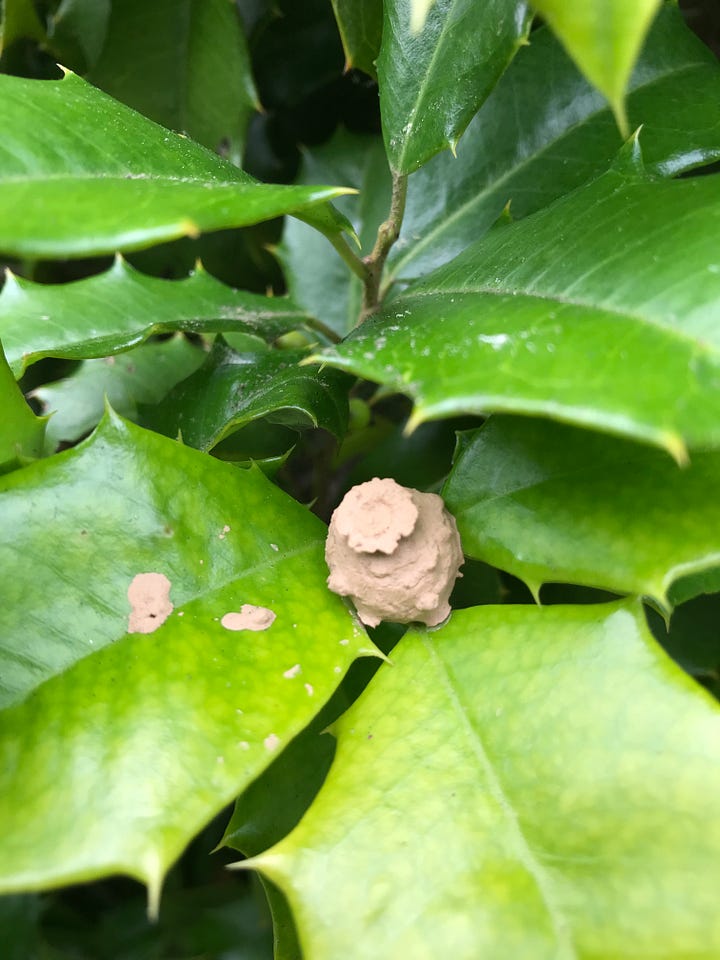

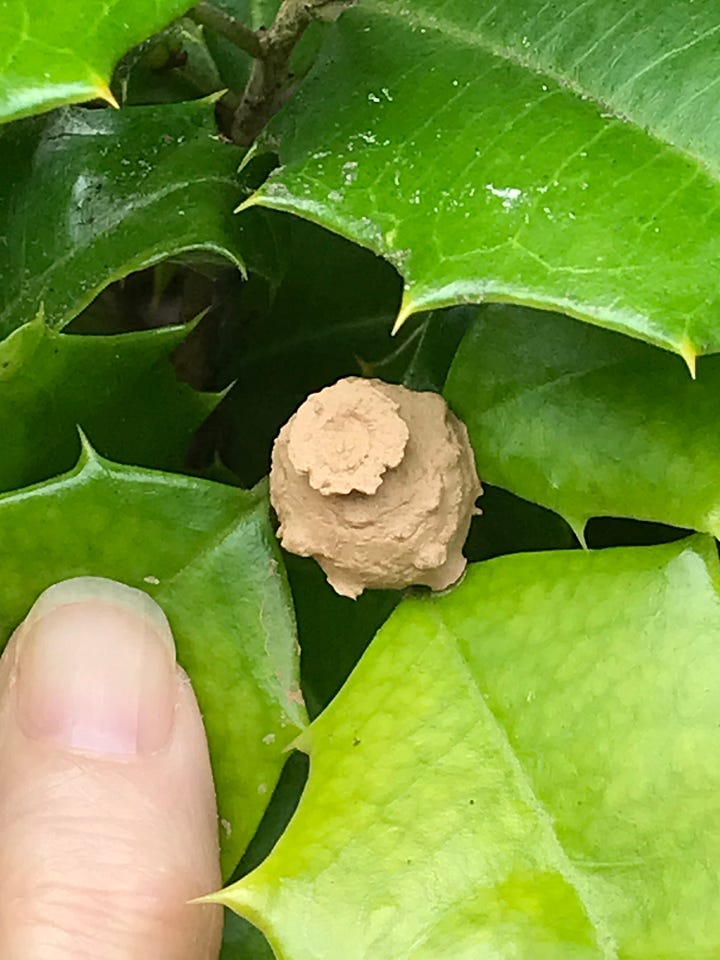
This is the work of the Potter Wasp who makes a small rounded jug-like nest and attaches it to leaves, twigs or other surfaces.2 A female collects water and mixes it with dry soil to create a little mud ball which she transports to the nest site and across what might be hundreds of trips over several hours, she fashions a pot. When she is finished and the top is still open, she then hunts for caterpillar or beetle larvae, paralyzes them with a sting and brings them back to place in the bottom of the vessel. She then lays a single egg above them, attaching it to the inside surface above the prey, and seals the nest with a clay plug. When the egg hatches, the wasp larva will then have enough food to sustain it for the rest of its pot-bound life. Every time I pass it in the holly bush, I give thanks for such a magical creation. It is so elegant and inspiring and it abundantly feeds my obsession with all-things-nest (which is a thing I have).
I also feel moved to share with you some of the other kith and kin that I feel privileged to spend time with here on the land. Not a day goes by that I am not astonished by some little someone or other (and many big ones). I resonate with what the poet, writer and spiritual teacher Mark Nepo says in The Book of Awakening: “The further I wake into this life, the more I realize that God is everywhere and the extraordinary is waiting quietly beneath the skin of all that is ordinary.” Here are some of the sacred smallies that are some of my extraordinary companions:


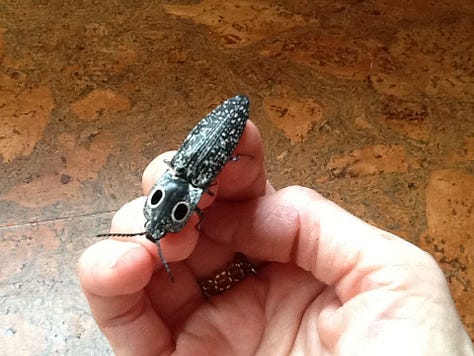
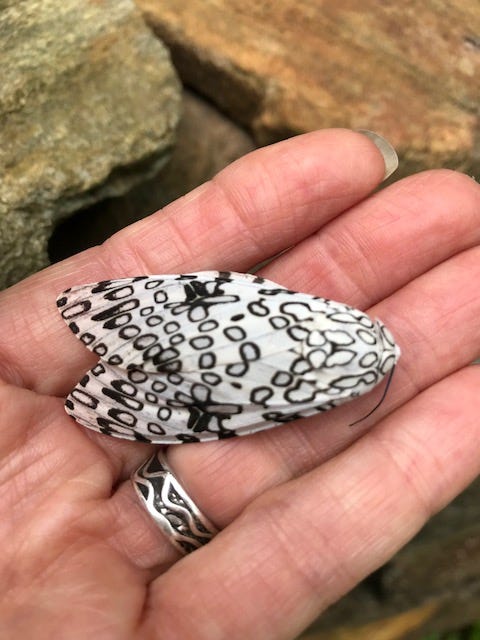
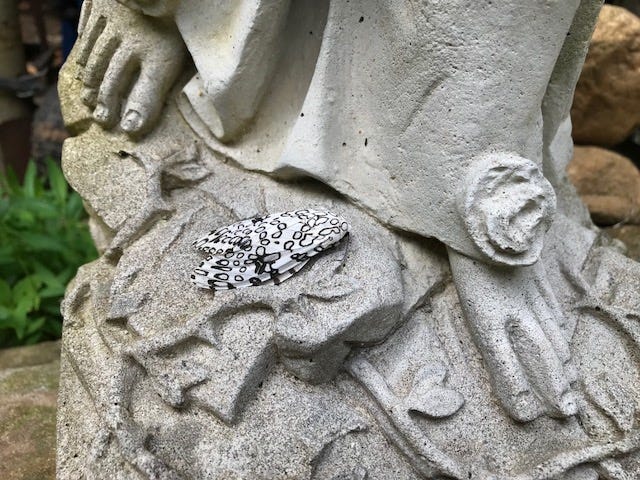
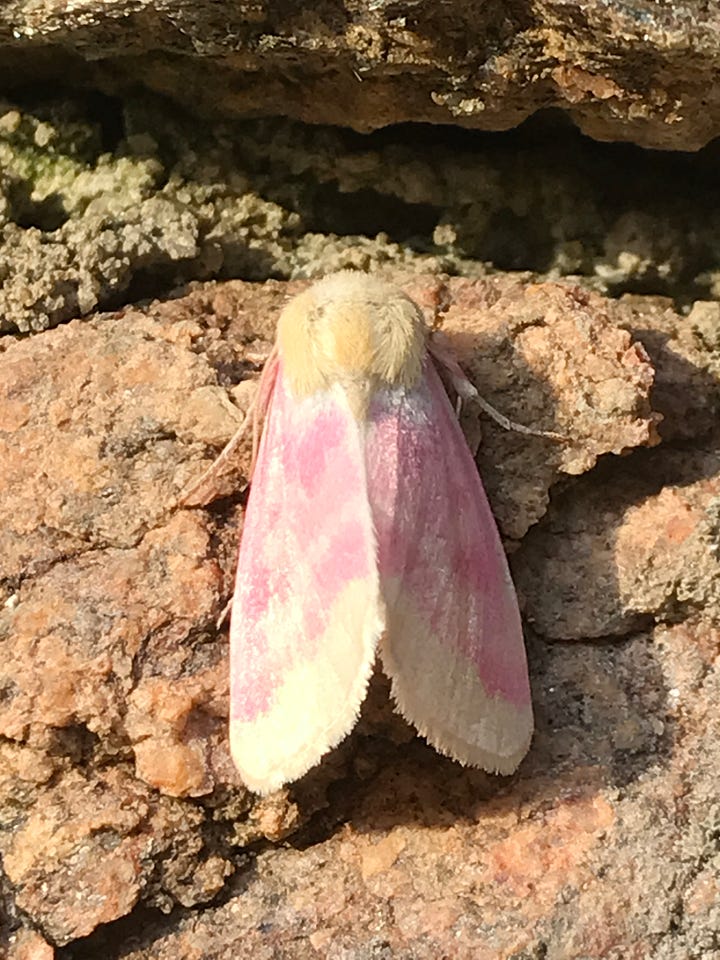
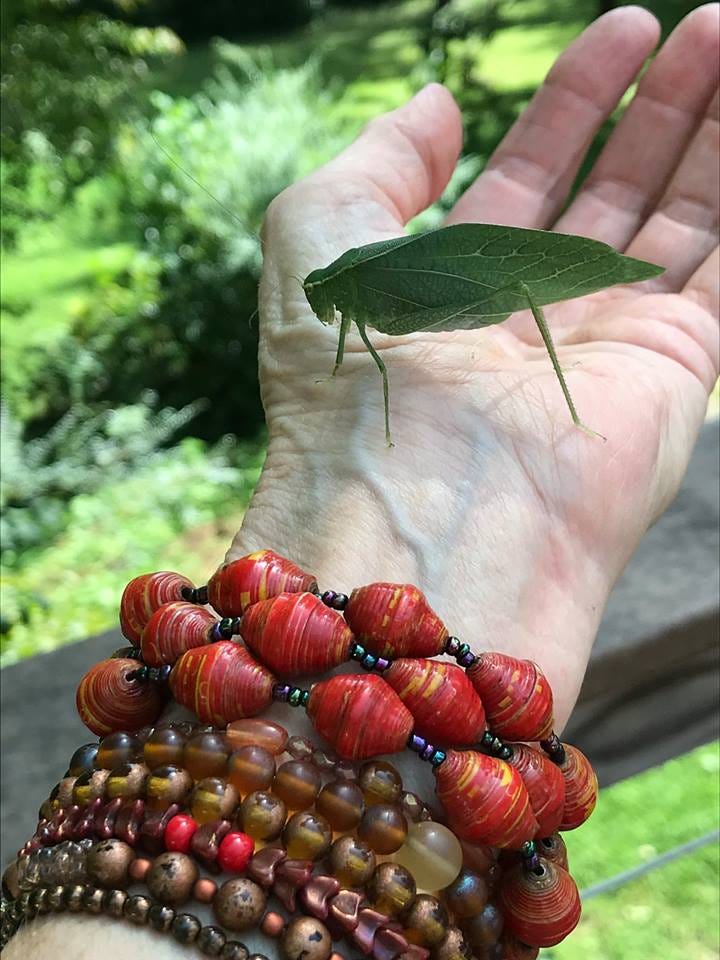
I met a Golden Tortoise Beetle (also called a Gold Bug) on the way to the bee sanctuary one afternoon. This insect has the amazing capacity to change its color depending on the season or their mood. Gold means they are relaxed and hydrated; other colors can result from stress. They can turn red, for instance, to mimic lady bugs and deter predators. (I completely took it personally that this one stayed golden during our time together 😎.)
The Eastern Eyed Click Beetle has these remarkable I am looking at you eyespots which are not really their eyes but a defensive marking to confuse or frighten potential predators. Their real eyes are much smaller and near their antennae.
Two less common moths have made a home here. One is a Giant Leopard Moth, a black and white creature I found at the feet of the Virgen de Guadalupe in the altar space in Joe’s Great Wall (I too am at Her feet.) And the other is the Rosy Maple Moth, a silk moth who sometimes sits on the yellow Evening Primroses. I have never seen an insect with pink and yellow coloring before and with each meeting, I experience that joy-becomes-solidarity that Ross speaks of.
It is Katydid time here in the mountains with their Katydid / Katydidn’t mating songs. The males “sing” by rubbing their wings together (called stridulation) and there is an increasingly loud ch-ch-ch nighttime soundtrack from now until late summer.
Such worlds within worlds … such tiny precious multiverses that are everywhere around us.
The poet Jane Hirshfield so often expresses what I am thinking, but in an infinitely more beautiful way (and with far less words). I love her poem, “A Cedary Fragrance”:
Even now,
decades after,
I wash my face with cold water –
Not for discipline,
nor memory,
nor the icy, awakening slap,
but to practice
choosing
to make the unwanted wanted.
It is so easy to lean into nature when we are with young animals like puppies or kittens; with flowers, birds, or trees; with faces we are familiar with … all the who’s who that we collectively agree are non-threatening, safe and acceptable beings. But there are so many others we share this life with that are overlooked, misunderstood and feared … especially the multi-legged, web-building, stinging, wriggling, slithering and surprising … all of whom have a sacred purpose in this world, even if we don’t understand it. If ever there were a time for the unwanted to be wanted, it is now.
Many of you will have heard of the remarkable environmental activist, author and Buddhist scholar, Joanna Macy. As I write this, she is in hospice care and in the process of peacefully transitioning. May peace be upon her. She wrote:
We belong to this world.
The web of life is calling us forth at this time.
We’ve come a long way and are here to play our part.3
Let is listen to all the voices, little to large. We are living prayers and so are the relatives around us. And all of us are somebody’s child.
I want to leave you with a favorite photo of a treasured friend … a toad whose family has lived beside our plant pots in the summer and more recently under the Ganesha altar in the garden wall. So many teeny beings in my life, so many big blessings, so many milagros.
Thank you for stopping by, Holy Mischievians. Bless our capacity to love. It is what holds us steady. Have a beautiful week suffused with every kind of wonder, joy and solidarity.
❤️ Debra
PS I have been doing a tango with laryngitis so I am not yet able to record this piece but I will get to it soon. Thanks for your patience.
PSS Sometime in these last few days, an adult Potter Wasp chewed its way out of its pot. Godspeed. Long life, honey in the heart.4
IMPORTANT ANNOUNCEMENTS FROM HOLY MISCHIEF LAND:
Hello dear Holy Mischievians. ❤️ We are crossing the half-year mark with Holy Mischief. It remains a joy to share our words, worlds and hearts with you. There have been so many precious, appreciative and tender sharings across the months, either in the Substack world itself or by email. Thank you. So much. We treasure you. We pour ourselves into each and every post. And so we have decided, in this grand, collaborative and ongoing experiment, to offer all the weekly newsletters, MUSEings and occasional Pop-Ups … everything … free of charge. If our words can uplift, heal, inspire or delight in any way, then we offer them freely to the world, especially in these Great Shaking times.
Having said that we would like to encourage you to consider becoming a paid subscriber for a monthly subscription fee of $6, if you love our content and would also like to support our labor of love. This form of exchange is much appreciated. And for all of you who already are, thank you. If you have any concerns (at all) about this change, please contact Debra at: debra@holybeepress.com.Stay tuned for our next pop-up on Saturday, July 26, on living prayer as a creative field to welcome the change we need in our lives. We will soon share an invitation with more details.
Blessings ❤️ Debra and Filiz
From “The First Incitement,” first chapter of Inciting Joy by Ross Gay. I cannot recommend this book highly enough.
“It has been suggested that these nesting chambers served the American Indians as models for the shape of their clay jars.” Extracted from Animal Architecture (p. 55) by Karl and Otto von Frisch. I have read this in several places and am exploring the truth of it with friends in the potters’ world.
From Active Hope by Joanna Macy. You have left your indelible loving mark on all our hearts. I give thanks for you. Go gently dear Joanna.
Long Life, Honey in the Heart is the name of a book by Martin Prechtel and a phrase I heard him speak many times when I knew him in my New Mexico days. Martin is a wonderfully gifted and great-hearted human amongst us.








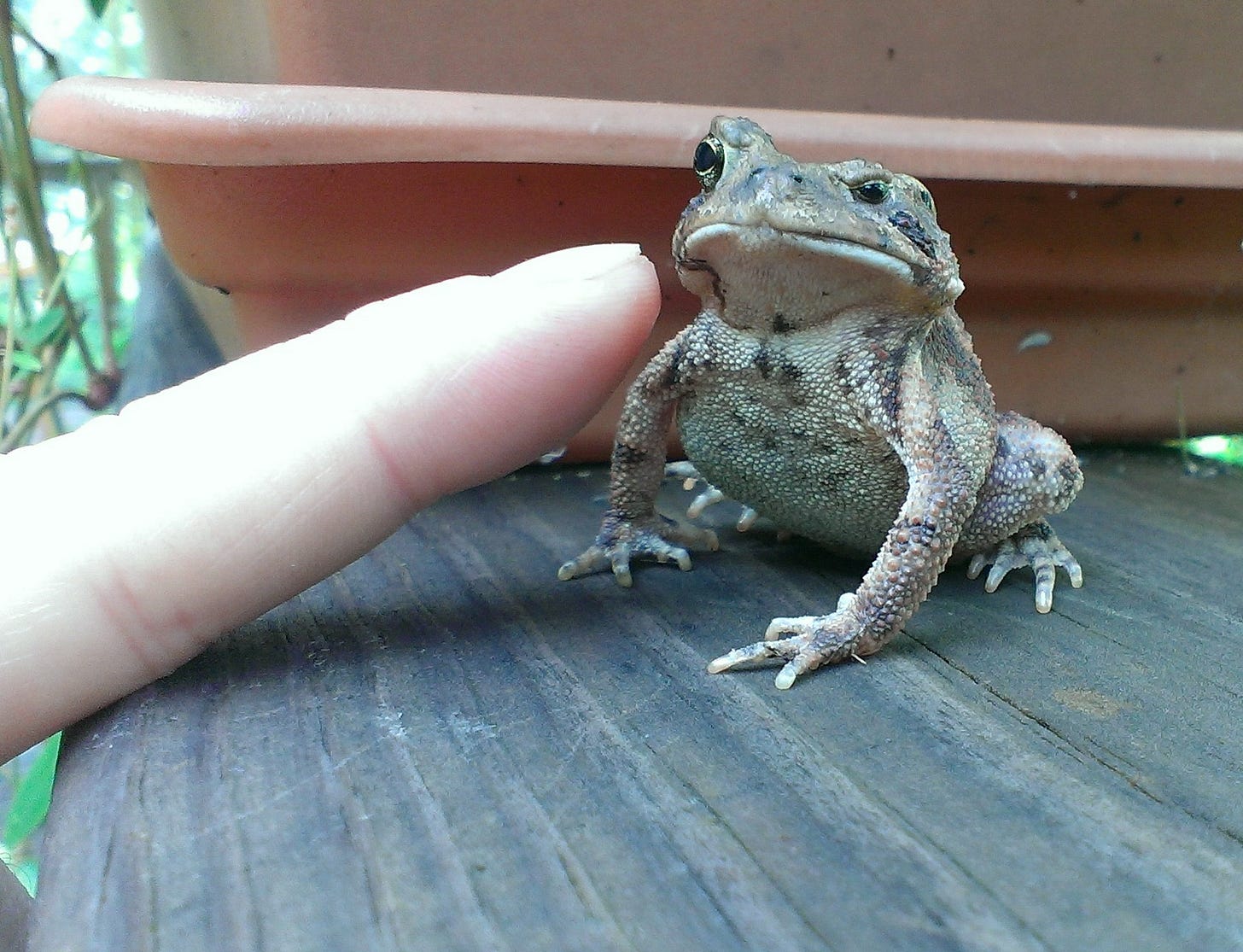

My Debraji, you truly walk the beauty way! I have been an apprentice to the way you see and appreciate the natural world and how you practice sacred relationship with all beings. And still the world through your eyes never ceases to amaze me, after all these years, still with such delightful and beautiful surprises about this precious life we get to live. I give thanks for all the beauty that reveals itself through the practice of presence. I give thanks for you. ❤️
Always the depth of sweetness and the wonders your eyes see brings all of us along on your holy ride.. thank you sweet mischievous Debra